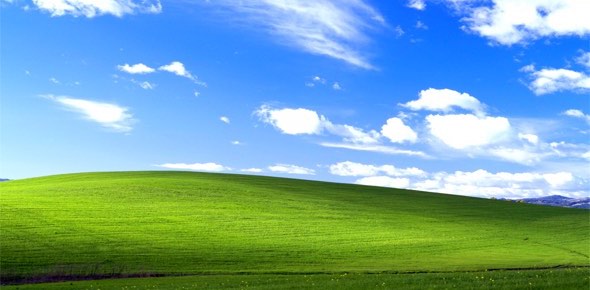People have been clicking away since the invention of cameras. And nowadays, with almost everyone carrying one on their person, in the form of a mobile phone, there has been a deluge of photos. Additionally, web services such as Facebook, Instagram, Twitter and Flickr have made distribution of images so easy.
There are countless famous, memorable and captivating photos. Unfortunately, a lot many of them, centre around poverty, grief, war or its repercussion… you get the idea. In this post, I’m going to tell you about the most important photos. They may not the most famous and certainly aren’t the “best” captures. But they changed the photography field in some way.
Sponsored Links
View from the Window at Le Gras – the oldest known photograph [1826 or 1827]
The oldest known photograph taken by a camera. The heliographic picture was taken by Frenchman Nicéphore Niépce, the inventor of the field of photography. The exact date is lost in time and the photo is presumed to be taken sometime in 1826 or 1827.
When it was born, photography was very different from what we know today. An image could only be captured by exposing the photographic plate for a long time, probably about 8 hours. The photograph shows the building and countryside. The original plate, after being in the hands of several owners, is now on display Harry Ransom Humanities Research Center in Austin, Texas.
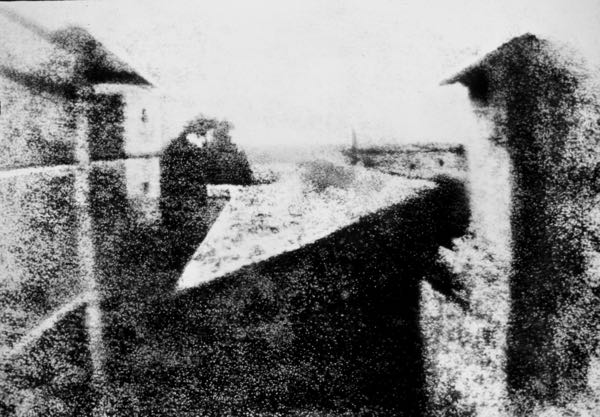
Image Source: By Joseph Nicéphore Niépce – Rebecca A. Moss, Coordinator of Visual Resources and Digital Content Library, via email. College of Liberal Arts Office of Information Technology, University of Minnesota. http://www.dcl.umn.edu, Public Domain, https://commons.wikimedia.org/w/index.php?curid=107219
Latticed window at Lacock Abbey – 1835
Latticed window at Lacock Abbey is a positive of probably the oldest surviving negative. It was created by Henry Fox Talbot, a British scientist who invented the “calotype” or “talbotype” photography process.
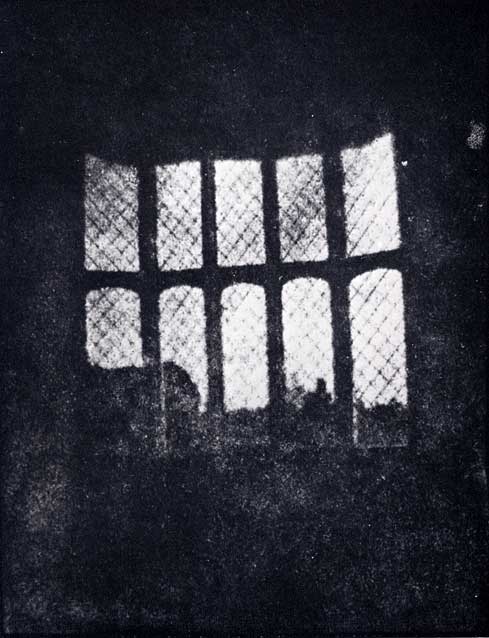
Image Source: By William Fox Talbot (1800-1877) – National Museum of Photography, Film and Television collection, Public Domain, https://commons.wikimedia.org/w/index.php?curid=4525845
Talbot’s story is interesting. He started developing his photographic process sometime in 1834 but kept it under wraps. Only when Louis-Jacques-Mandé Daguerre announced Daguerreotype (more on this below) did the Britisher approach Royal Institution with paper photographs he had made in 1835 and ascertain his claim for being the first to invent the photographic process. But calotype was very different from the Daguerreotype.
Boulevard du Temple – the first candid shot [1838]
Louis-Jacques-Mandé Daguerre, best known for inventing the photography process of daguerreotype, is credited to have taken the first candid shot. The photograph was taken on a busy street but because of the long exposure, the moving traffic is absent. However, on the footpath, a man was getting his boots polished. Both the man and the shoeshiner were relatively still to have their images captured in the photograph.
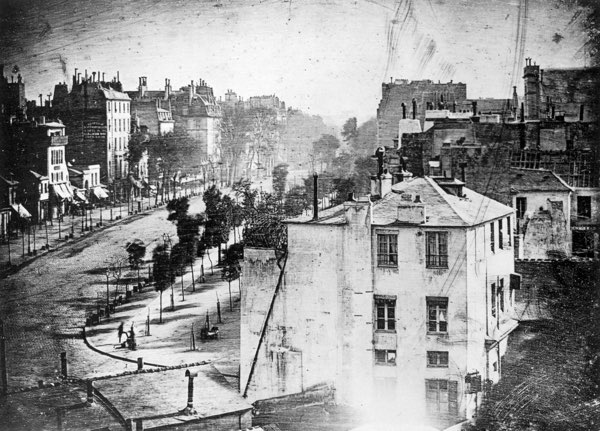
Image Source: By Louis Daguerre – Scanned from The Photography Book, Phaidon Press, London, 1997., Public Domain, https://commons.wikimedia.org/w/index.php?curid=5005681
Daguerre was a contemporary of Nicéphore Niépce and even collaborated with him in 1829. The two frenchmen would be regarded as the founding fathers of photography. After the Niépce sudden death, Daguerre continued working and came up with the daguerreotype process. It was finally announced by the French Academy of Sciences on 9th January 1839.
A few months later, the French government proclaimed that Daguerreotype would be “free to the world“. This lead to the immense popularity of the process and millions of photographs were produced.
The first light Picture ever taken – the first selfie [1839]
The first selfie was a daguerreotype taken by American photography pioneer, Robert Cornelius. He uncapped the lens, ran in front of the camera and returned after the proper exposure time.
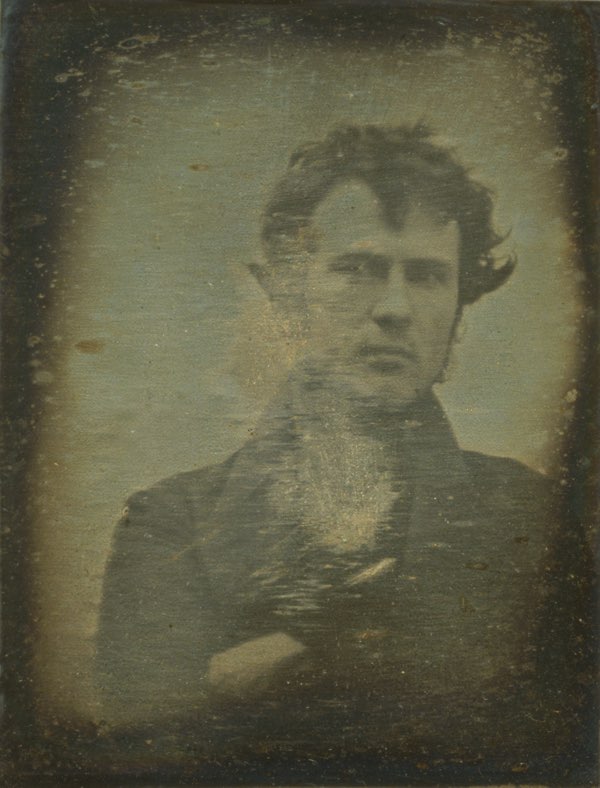
Image Source: By Robert Cornelius – This image is available from the United States Library of Congress’s Prints and Photographs division under the digital ID cph.3f04912.This tag does not indicate the copyright status of the attached work. A normal copyright tag is still required. See Commons:Licensing for more information.العربية | čeština | Deutsch | English | español | فارسی | suomi | français | עברית | magyar | italiano | македонски | മലയാളം | Nederlands | polski | português | русский | slovenčina | slovenščina | Türkçe | українська | 中文 | 中文(简体) | 中文(繁體) | +/−Library of Congress; Transferred from en.wikipedia to Commons., Original uploader was Blackmagictea at en.wikipedia, 2006-07-17 (original upload date), Public Domain, https://commons.wikimedia.org/w/index.php?curid=6350177
The Horse in Motion – 1878
The Horse in Motion is a series of photographs taken by English inventor and photographer, Eadweard Muybridge, on the behest of Leland Stanford, the founder of Stanford University.
At that time, there was an ongoing debate whether the legs of a horse touch the ground or not during a trot or gallop. Stanford believed that all four legs would be in the air and wanted to have this proven “scientifically”. He contacted Muybridge who had earned quite a name with his photographs of the Yosemite Valley and the American West.
On 15th June 1878, the photographer set up his equipment on Stanford’s Palo Alto Stock Farm and took the, now famous, series of photographs. The Horse in Motion, also known as Sallie Gardner at a Gallop, clearly showed that during gallop all four legs of a horse are in the air.
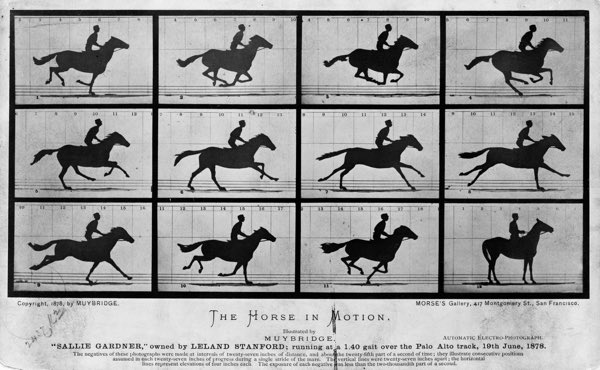
Image Source: By Eadweard Muybridge – Provided directly by Library of Congress Prints and Photographs Division, Public Domain, https://commons.wikimedia.org/w/index.php?curid=57260211
Settling the debate wasn’t the highlight of Muybridge’s experiment. The consequence having those photographs in a series was more important. When they were displayed in sequence, it resulted in animation… a “video”. Muybridge used his invention, the zoopraxiscope, to create one of the first “motion pictures”!
Walden Kirsch – The first digitally scanned image [1957]
The first digital image was made by Russell Kirsch, an American engineer and the creator of the world’s first digital image scanner. In 1957, Kirsch and his team scanned several images including one of his three-month-old son, Walden.
The 176 X 176 pixels image has a total of 30,976 pixels. This was all that the computer they used could store! Thus, the first digital photograph wasn’t taken from a camera but was result of an image scan!
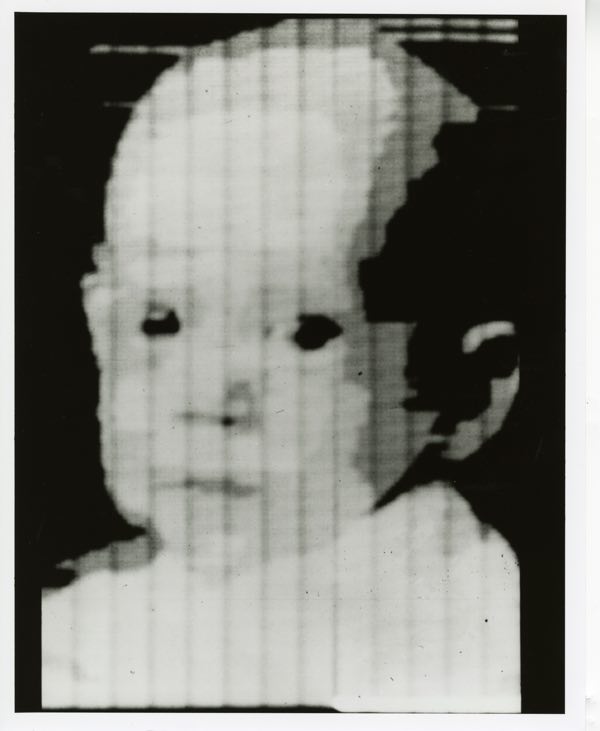
Image Source: By Russell A. Kirsch – National Institute of Standards and Technology, Public Domain, https://commons.wikimedia.org/w/index.php?curid=2437615
Les Horribles Cernettes – probably the first photograph on the web [1992]

Image Source: By Source, Fair use, https://en.wikipedia.org/w/index.php?curid=29575353
A photograph of Les Horribles Cernettes, which means The Horrible CERN Girls, was “probably” the first one to be put up on the World Wide Web. The picture has four ladies, from left to right – Angela Higney, Michele de Gennaro, Colette Marx-Neilsen, Lynn Veronneau.
However, the photographer, Silvano de Gennaro, has stated that this may not be true and that the media “totally distorting our words for the sake of cheap sensationalism“.
Bliss – the Windows XP default wallpaper [1996]
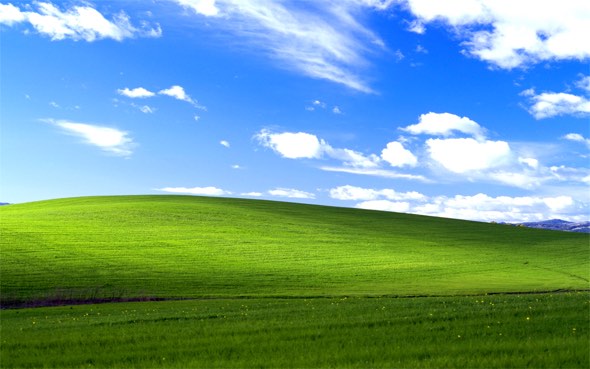
Image Source: By Source, Fair use, https://en.wikipedia.org/w/index.php?curid=4705583
Taken by Charles O’Rear, a former photographer for the National Geographic, the beautiful photograph of Sonoma County, California, has adorned countless computer screens and is one of the most recognisable pictures in the world.
The surprising fact is that, except for being cropped, the picture has been untouched digitally – there has been no enhancement or embellishment. The photograph film and it’s rights were bought by Microsoft from O’Rear for a six-figure price!
We though of including Bliss in this list because it shows the impact the digital age has had in making something timeless!
To know more, please read our post on the interesting story of Bliss, the Windows XP wallpaper.
Trojan Room coffee pot – The last picture of the world’s first webcam [2001]
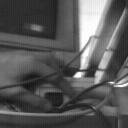
Image Source: By Daniel Gordon, Martyn Johnson and Quentin Stafford-Fraser – http://www.cl.cam.ac.uk/tmp/xvcoffee.jpeg, CC BY-SA 3.0, https://commons.wikimedia.org/w/index.php?curid=1313565
The world’s first webcam was set up to monitor a coffee machine near the Trojan Room at the University of Cambridge, England. Why a coffee machine? So that people in the building would know when it is empty and, thus, save them disappointment and a futile trip.
Considering it was Britain, wouldn’t tea be more appropriate?

Anyway, the plug from the webcam was pulled off on 22nd August 2001 and the last picture it took, shows it being switched off!


